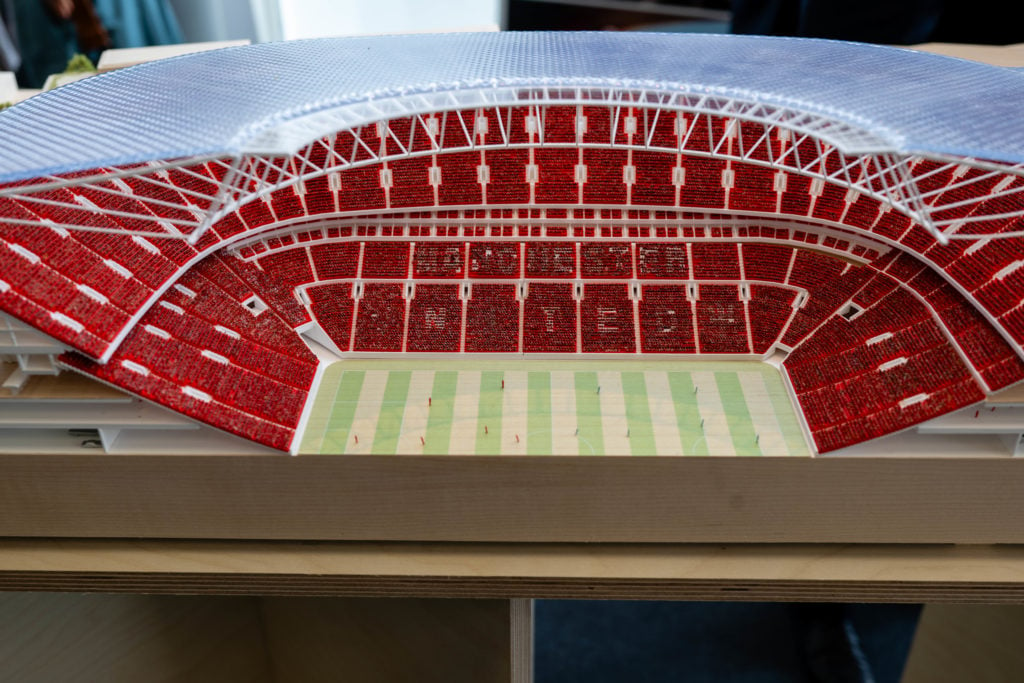It has been over half a year since Manchester United revealed plans for a new state-of-the-art stadium.
After months of deliberating over whether to expand Old Trafford or build a new venue, United published concept images of a 100,000-seater stadium back in March.
Sir Jim Ratcliffe expects the stadium to be built by 2030, but the Red Devils have already come across some major hurdles.
![]() Join our newsletter for news & smart analysis.
Join our newsletter for news & smart analysis.
United are being quoted £400m for a land purchase next to Old Trafford, which would be essential for the stadium project to go ahead. Considering work on the stadium was set to begin this year, it has been a frustrating few months with a real lack of progress made.
There are now major concerns that United’s stadium could be delayed, and football finance expert Kieran Maguire believes further compromises will be made to the design itself.
 Photo by Ash Donelon/Manchester United via Getty ImagesMan United could reduce capacity of new stadium
Photo by Ash Donelon/Manchester United via Getty ImagesMan United could reduce capacity of new stadium
Old Trafford already boasts the title of the biggest club stadium in England with a capacity of 74,310 seats, but Ineos know the club can go bigger.
A 100,000-seater stadium would even overshadow Wembley, which has a capacity of 90,000.
But United in Focus spoke exclusively to Kieran Maguire, and he believes a reduction in size is on the horizon.
“I think there will be an element of scapegoating taking place,” Maguire said.
“They’ve still not got planning permission. They have to go through that before the first brick is laid.
“Interest rates are much higher than they were when Spurs borrowed for their stadium. Labour costs have increased, labour tax has increased, material costs have increased, and fuel and power costs are your broad overheads and they’ve increased in price.
“So I would be surprised if United can do this on budget. I expect to see compromises being made, we’ve already seen that with the somewhat laughable canopy idea being dropped.
“I would anticipate that the next big decision will be in terms of ground capacity. 100,000 seats is not necessary. If you take a look at the big stadiums in the United States, which is a far bigger country and has far greater land resources, the sweet spot is in that 70-80,000.
“And the breakdown of seats will be targeting the corporate sector. Manchester United are no strangers to the prawn sandwich brigade, because it’s the football club for non-football fans to support, and that’s not a dig at genuine Manchester United fans.”
Ineos might have to break promises to Man United fans
When the concept images of United’s new home were shared, it came at a time when the club was in terrible form and in need of distraction.
Talk of the new stadium helped to divert attention away from the disastrous 2024/25 Premier League campaign and promise hope of a bright new future.
United could earn £230m per year from a 100,000-seater stadium if Ineos are able to follow through with their plans, but it looks less and less likely each month.
Selling out such a capacity would not be an issue for United’s fanbase, but funding and planning for a venue of that size is where the problems lie.
The stadium canopy design has been scrapped, and that feels like the first of many stadium promises that Ineos are going to have to break.
A 2030 deadline looks unrealistic and a £2bn stadium budget seems overly ambitious. Now, even the 100,000-capacity might be retracted.

